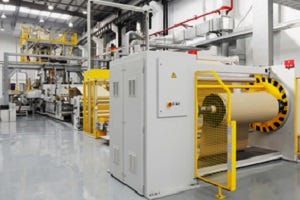A new production line for interior film skins fabricated from thermoplastic polyolefin (TPO) went into operation in Zhangjiagang, Jiangsu Province, eastern China in October last year. The new production capacity is being added in response to the steady growth in demand in the Chinese automotive industry for high-quality TPO films.
March 24, 2014
A new production line for interior film skins fabricated from thermoplastic polyolefin (TPO) went into operation in Zhangjiagang, Jiangsu Province, eastern China in October last year. The new production capacity is being added in response to the steady growth in demand in the Chinese automotive industry for high-quality TPO films.
The plant is operated by Benecke Changshun Auto Trim, a joint venture of Benecke-Kaliko (Hannover, Germany) and Jiangsu Changshun Group (Zhangjiagang, China).
Available as compact films and foam sheets, the TPO films have various applications that include instrument panels, door paneling and center consoles. For the new TPO production line, Benecke Changshun Auto Trim has practically built its own new factory, complete with production hall, numerous ancillary rooms and a warehouse at a cost of around EUR7 million ($9.7 million).
From silo to film extruder, ProTec Polymer Processing (Bensheim, Germany) designed and implemented all of the material supply equipment for this film production line in Zhangjiagang. In addition to supplying virgin product as specified in material formulations, this system also creates value by returning regrind from the continuous edge trimming that is inevitably created during production and the "balls," that are formed upon process start up after a change of material, back into the process.
Since TPO interior films are up to 50% lighter than the conventional PVC films that are still often used in automotive skins, and because the rubbery material tends to stick together, TPO regrind exhibits significantly impaired flow characteristics. As a result, the regrind conveyor had to be equipped with special process controls and plant technology that adapted to the unique flow characteristics.
|
TPO line takes on unique challenges of processing regrind. |
|
Demand for high quality, TPO-based automotive skins is growing in China. |
The film extruder, a twin-screw extruder, is run underfed. Throughput is regulated by a Somos Gramix S9 gravimetric dosing and mixing system fitted above the material feeder. It can handle up to nine components (primary and secondary components in different ratios depending on the formulation). Two of these can be regrind components, which are separated for light and dark regrind types. The extruder is operated with a throughput of up to 800 kg/h; the regrind proportion in this case can be up to 50 %.
Flexible regrind conveyance
The configuration of conveyance routes for the regrind is extremely flexible. Starting from the two mills - one for crushing the edge trims and one for crushing the balls - the regrind can either be conveyed directly to the dosing station at the extruder, to an upstream mixing funnel, or to a big-bag packing station. The latter handle larger volumes of material that cannot be returned directly to the production process, for example, when the start-up balls are crushed. These fractions are then temporarily stored in big bags until the same film type is being produced. This regrind then passes from a big-bag emptying station to a mixing funnel, where it is homogeneously mixed with the edge trim regrind also being fed back from current production, before being dosed into the material flow at the extruder feeding device. The mixing funnel is designed to allow trouble-free operation of the extruder with a regrind flow of up to 200 kg/h.
To ensure that the adhesive TPO regrind can be reliably conveyed, the system incorporates several special features - the first of which is the stronger torque specification of the mixing screw in the mixing funnel. The material is also discharged or dosed from the funnel by a discharging screw conveyor before it can then be conveyed by a suction conveyor along pipes to the dosing station. Material is discharged from the big-bag emptying station in the same way. The material supply hoppers for the regrind - at ProTec Polymer Processing these are special hoppers with asymmetrical walls - at the dosing station, the mixing funnel and the big-bag filling station were also fitted with loosening agitators to ensure that the regrind, which is extremely light (bulk weight of just 150 g/l) but has a tendency to stick, remains free-flowing at all times. Another special feature of the equipment installed to handle regrind is the provision of duplicate mixing funnels, filling, and emptying stations for the big bags: one set for all light and the other for all dark material batches. This enables quick color changes with minimal loss of material.
The Somos Gramix S9 gravimetric dosing and mixing system is reportedly suitable for supplying extruders operating in overfeeding or underfeeding mode, continuous production processes used in coextrusion or blow molding applications with a longitudinally homogeneous material mixture and at throughputs of up to 2,400 kg/h. Thanks to the highly dynamic weighing electronics built into the system, even the smallest additive volumes of just 200 g/h - equivalent to around three grams per minute - can reportedly be dosed reliably with an accuracy of ± 1 % (or up to 0.5 % for higher throughputs). Extremely fast weighing processes and short weighing intervals result in very short communication and reaction times. This ensures that even intermittent fluctuations in the throughput of the processing machine can be quickly corrected. For example, this allows an extruder to start up with very low material losses, while the quick detection of anomalies is also said to reduce overall production waste.
The dosing system features convenient operation via touch-screen display and offers diverse display and evaluation functions. Current process states in the dosing system can be intuitively detected while any outages and faults are indicated textually. The Gramix controller also automatically detects the dosing screws used in the individual dosing stations. If a screw is changed, for example, to increase the throughput, the correction of dosing values takes just a few seconds. This avoids mistakes in the composition of the mixture.
About the Author(s)
You May Also Like




